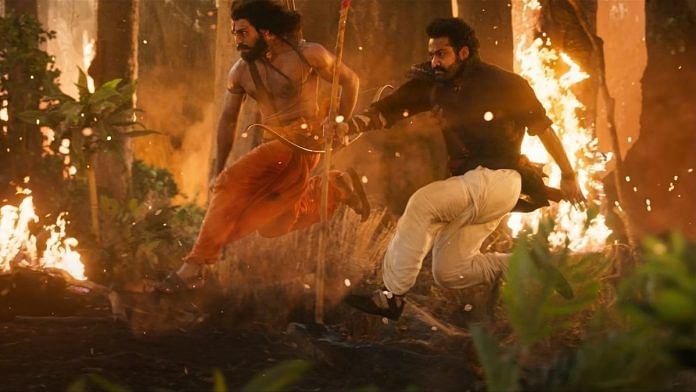S. S. Rajamouli’s RRR is a lot of things, but at its core, it is fulfilment of a connection between Ram and Bheem to take down the British. The bromance between Alluri Sitarama Raju, played by Ram Charan, and Komaram Bheem, played by N.T. Rama Rao Jr., never fades, even for a second. In fact, it’s like the Captain America-Iron Man saga of friendship, betrayal and reconciliation. For the desi audience, the ‘brown munde’ are a force to reckon with, as they dance and fight their way against the ‘firangis’.
Even in the fiercest battles, including the one between them, there is a tenderness of the bond they fostered. The friendship, however, starts off between Ram and Akhtar, the pseudonym used by Bheem, to protect his identity from the British. The Hindu-Muslim friendship flourishes — biryani to ‘matka tod’ — and in lessons on how to impress a ‘gori mem’. It is also a friendship between the simpleton and the revolutionary, the tribal and the Kshatriya.
Good vs evil
The film is a tale of good versus evil. Rajamouli relies heavily on mythology, be it his 2015 blockbuster Baahubali or RRR. From the reference to Ramayana with the Ram-Sita love story to the killing of the ‘Raavan’ by the two ‘brothers’, albeit from another mother, in this case, RRR is rife with undertones from the epics. In fact, in an interview not so long ago, Rajamouli had said: “It is completely embedded in my blood. Whatever goes in, comes out. I have so much input of mythology, it comes out in my stories in different forms. I feel very proud of it.”
Though the disclaimer states that the characters are fictional, it has been widely speculated that the two leads are based on real freedom fighters who have not received their due recognition.
Rajamouli creates a dimension in RRR where two worlds collide — one of Komaram Bheem, a Gond tribal leader from Telangana and the other of Alluri Sitarama Raju, a freedom fighter and a tribal leader from Andhra Pradesh. While Bheem had fought against Nizam of Telangana and the British Raj with the slogan ‘Jal, Jangal, Zameen’, Raju’s rebellion against the colonial rulers had come as a response to the 1882 Madras Forest Act, which effectively restricted the free movement of Adivasis. Perhaps it’s apt to imagine a confluence of two historic figures who shared a common cause.
Also Read: Not a cop-out — Dulquer Salmaan’s film Salute shows breach of ethics in police force
The caste angle in RRR
The caste angle is almost impossible to miss. In RRR, Bheem belongs to a tribal community while Alluri comes from the Kshatriya caste. The ‘refined’ Ram teaches Bheem the ways of the world, while Bheem ensures Ram never forgets his roots. The caste lines are removed when the two are viewed through their friendship. And their relationship is collaborative — one helps the other become a better person.
Although their alliance is fictional, the time in which the movie is set — the 1920s — is very real. Most British characters are portrayed as evil, except for Jennifer (played by Olivia Morris), much like Elisabeth Russell in Lagaan (2001), who falls in love with the ‘native’, Bheem.
There is also a reference to Hathras as a place where Bheem takes temporary refuge. It cannot be a coincidence that the place referenced in the film is where a Dalit girl was gangraped by ‘upper’ caste Brahmins.
Also Read: The Kashmir Files tries showing 1990 exodus ‘truth’ but Vivek Agnihotri gives it death blow
Visual splendour of S. S. Rajamouli
S. S. Rajamouli is well known for his detailing and visual effects. And RRR is no different. Every scene is a visual splendour — be it the lush green forests of Adilabagh, the dance sequences, fight scenes or even conversations between the two male leads. The movie’s trailer hailed it as ‘the biggest spectacle of Indian cinema’, and it undoubtedly delivers. The VFX is on point, much like his last blockbuster, Baahubali.
While Baahubali’s strength lay in its setting, RRR rests its foundation on the Indian freedom struggle and its heroes, who rose from humble backgrounds. The heroes aren’t kings, but rebels who fight against the establishment, represented by the British.
Ajay Devgn makes an unforgettable cameo. In fact, he has been lately been indispensable, even in cameos, be it in Gangubai Kathiawadi and now in RRR. Needless to say, Devgn excels in his limited screen time, showing why he is still his own brand. Alia Bhatt has a short role, and she does it well.
RRR is a spectacle you should definitely watch on 3D. It may be the good ol’ tale of good vs evil, but it packs everything that Indian cinema offers, plus spectacular VFX.
(Edited by Srinjoy Dey)



